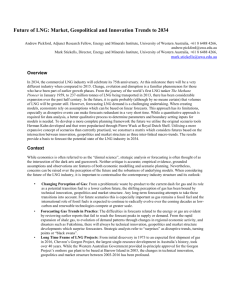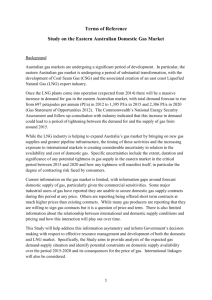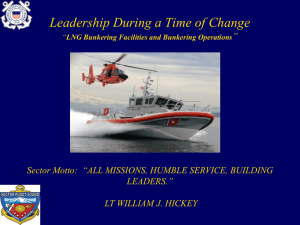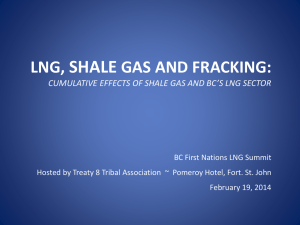lng operational developments - Nautical Institute London Branch
advertisement
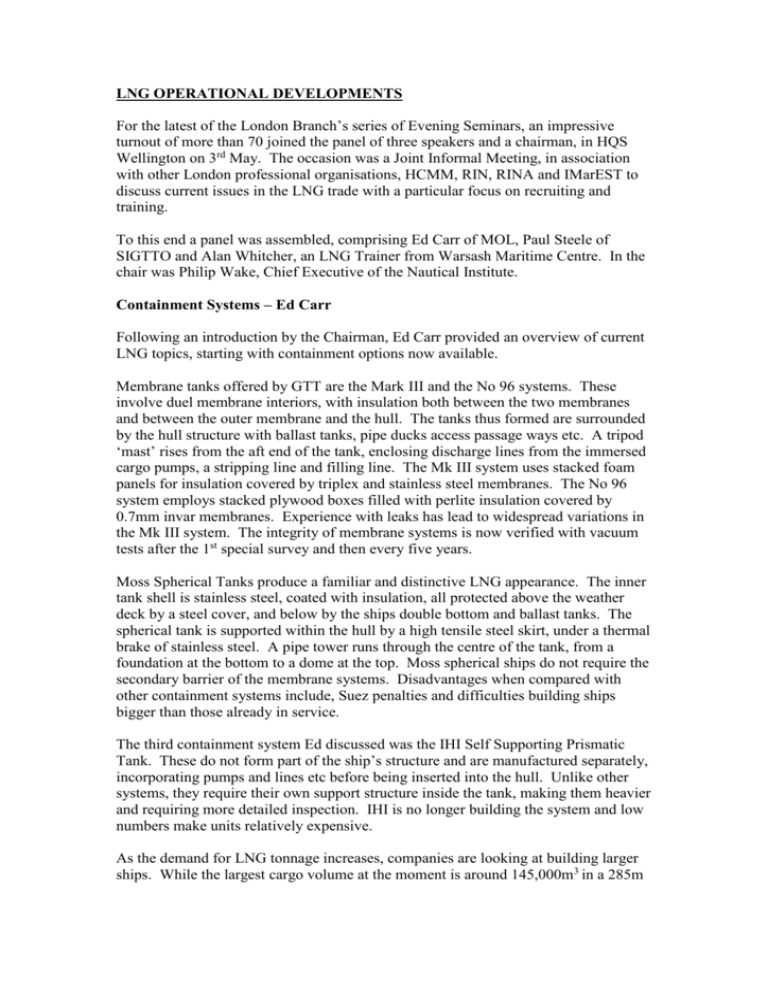
LNG OPERATIONAL DEVELOPMENTS For the latest of the London Branch’s series of Evening Seminars, an impressive turnout of more than 70 joined the panel of three speakers and a chairman, in HQS Wellington on 3rd May. The occasion was a Joint Informal Meeting, in association with other London professional organisations, HCMM, RIN, RINA and IMarEST to discuss current issues in the LNG trade with a particular focus on recruiting and training. To this end a panel was assembled, comprising Ed Carr of MOL, Paul Steele of SIGTTO and Alan Whitcher, an LNG Trainer from Warsash Maritime Centre. In the chair was Philip Wake, Chief Executive of the Nautical Institute. Containment Systems – Ed Carr Following an introduction by the Chairman, Ed Carr provided an overview of current LNG topics, starting with containment options now available. Membrane tanks offered by GTT are the Mark III and the No 96 systems. These involve duel membrane interiors, with insulation both between the two membranes and between the outer membrane and the hull. The tanks thus formed are surrounded by the hull structure with ballast tanks, pipe ducks access passage ways etc. A tripod ‘mast’ rises from the aft end of the tank, enclosing discharge lines from the immersed cargo pumps, a stripping line and filling line. The Mk III system uses stacked foam panels for insulation covered by triplex and stainless steel membranes. The No 96 system employs stacked plywood boxes filled with perlite insulation covered by 0.7mm invar membranes. Experience with leaks has lead to widespread variations in the Mk III system. The integrity of membrane systems is now verified with vacuum tests after the 1st special survey and then every five years. Moss Spherical Tanks produce a familiar and distinctive LNG appearance. The inner tank shell is stainless steel, coated with insulation, all protected above the weather deck by a steel cover, and below by the ships double bottom and ballast tanks. The spherical tank is supported within the hull by a high tensile steel skirt, under a thermal brake of stainless steel. A pipe tower runs through the centre of the tank, from a foundation at the bottom to a dome at the top. Moss spherical ships do not require the secondary barrier of the membrane systems. Disadvantages when compared with other containment systems include, Suez penalties and difficulties building ships bigger than those already in service. The third containment system Ed discussed was the IHI Self Supporting Prismatic Tank. These do not form part of the ship’s structure and are manufactured separately, incorporating pumps and lines etc before being inserted into the hull. Unlike other systems, they require their own support structure inside the tank, making them heavier and requiring more detailed inspection. IHI is no longer building the system and low numbers make units relatively expensive. As the demand for LNG tonnage increases, companies are looking at building larger ships. While the largest cargo volume at the moment is around 145,000m3 in a 285m long hull, there are proposals on the drawing board for ships up to 345m long, carrying 250,000m3. Propulsion Developments Another interesting area discussed by Ed was propulsion. Traditionally, LNG vessels are fitted with duel fired steam plants that burn the Boil-off Gas (BOG) from the cargo, which would otherwise be vented to atmosphere. This not only makes good use of BOG, but also allows it to be controlled. It is rare for an LNG vessel to take bunkers! Among the drivers that are leading to change, is technology that makes reliquefaction of LNG viable, allowing BOG to be returned to the cargo. Other issues are emission control, reducing availability of suitably skilled steam engineers and the limit that steam turbines place on the size of a vessel. The first alternative to steam is Heavy Fuel Oil (HFO) burning slow speed diesel propulsion, used in conjunction with a reliquefaction plant that returns BOG to cargo. Another is a duel-fuel medium speed diesel electric plant, with a single screw. Finally, Ed mentioned a concept that takes the diesel-electric plant a step further! The traditional steam plant is flexible in that it will operate on HFO, BOG or both. The main turbine would produce 30 - 40,000 SHP for a single fixed pitch propeller, and electrical power be derived from a 6 MW turbo-alternator plant. Gross thermal efficiency is around 28%. An HFO burning slow speed diesel ship would utilise a reliquefaction plant to control Boil-off Gas and return it to cargo. Propulsion, electrical power and auxiliary machinery would be more like that found in other modern tonnage, driving twin screws, with shafts fitted with clutches and brakes. This makes recruiting and training of Engineers easier and produces a gross thermal efficiency of 42%. The diesel-electric option Ed illustrated, involved electric motors of around 11.7 MW, with power supplied by four compact duel-fuelled generator sets with a 32 MW total capacity. These can burn gas, HFO or MDO – combinations being possible with more than one set in use. Low emissions are thus achieved due to high engine efficiency, clean fuel and lean burn combustion. The plant gross thermal efficiency is 43%. For the last option, substitute the diesel generator sets above with a gas turbine ‘power station’! This concept consists of a 36 MW gas turbine engine, a steam turbo alternator producing a further 10 MW and a 5 MW auxiliary engine. As the plant burns only BOG or Gas Oil, lower exhaust emissions are achieved and a thermal efficiency of 44%, all with a plant that requires a significantly smaller engine room. Not such an old fleet Drawing his briefing to a close, Ed mentioned the age profile and quality of the LNG fleet. As the fleet expands and older, less efficient ships are being replaced with new tonnage, a little under half the fleet is less than five years old. LNG is a non- corrosive, high value cargo and as customers demand high reliability, maintenance standards are kept high. Some quick questions followed including a enquiry as to the ability of terminals to accept the larger tonnage on the drawing board. Ed said the driver for the size increases were long voyages and that tank sizes remained comparable. Terminals on these runs would adapt as required. Pressurised? Small gas fields..? Layout? .. Accom fwd, cargo aft etc.. Manning Paul Steele of SIGTTO then stepped up to deal with one of the main questions to be addressed by the seminar, that of safely manning the expanding fleet. The challenge facing the industry in this area was highlighted by a statistic: 199 LNG vessels in service now and a further 150 or so on order due for delivery before 2010! It was not surprising to hear therefore, that the shortage of skilled personnel affecting the whole industry is particularly acute for LNG carriers. Given the planned expansion, thousands of additional officers are going to be required for the LNG trade, and that is in addition to those that would be needed to maintain present manning levels following retirement of existing personnel. These recruits are joining an industry that is proud of its safety record over the last forty years. The experience that has achieved and maintained this record will now be diluted increasingly, making it harder for newcomers to gain the necessary skills to take the industry forward. Training Most experienced LNG operators, have increased their training afloat to the limit that available berths will allow. In addition, further training is available ashore, over and above that required for the issue of a Liquefied Gas Tanker Endorsement. The SIGTTO Training Project has developed competency standards for all ranks, around which training courses may be based. Interested parties such as charterers have expressed an interest in accepting training in accordance with the SIGTTO guidelines, along with their experience profile, as evidence of a seafarer’s suitability for employment in LNG vessels. Evidence of the dilution of skills onboard is possibly emerging, as the number of incidents occurring onboard LNG vessels increases. To encourage accurate reporting of these, SIGTTO has a confidential reporting scheme, similar to MARS. This will hopefully allow the monitoring of trends and subsequent feedback to the industry. More Complicated Cargo Operations Alongside problems of competent manning, the cargo operations required in an LNG carrier are becoming more complex. For instance, ballast voyages, for which some of the previous cargo is normally retained as ‘heel’ to keep the tanks cool ready for the next load, and to provide fuel. Increasingly, the cargo’s value and the propulsion developments previously described by Ed, discourage this practice, so cargo tanks have to be cooled again before arrival at the next loading port. New tonnage will also bring new difficulties, and Paul stressed the need to allow time for gas trials to test and prove all the systems in a new build and avoid the temptation to rush a vessel into service. In the short term, an effective way to use some of the limited expertise, may be as LNG superintendents, attending certain vessels for more complicated cargo operations, to support ship’s staff. Paul concluded by highlighting the management challenge that faces the rapidly expanding LNG fleet, but suggested that it could be met with proper planning. The Training Provider Training obviously needs to be at the heart of this planning, which is where the final speaker Alan Whitcher, from Warsash Maritime Centre (WMC) stepped in. Following an introduction to WMC’s history in tanker operations training with simulators, Alan described the STCW requirements for the Tanker Endorsement (Liquefied Gas). He pointed out that the syllabus is pretty generic, focusing on general safety issues with cargo operations forming only part of the training. As the qualification is for any liquefied gas, LNG is just one of a range of cargoes covered. Although the Tanker Endorsement is only required by senior officers and those with cargo duties, in recent years pressure form port states has led many companies to give all officers this training. In many cases therefore, junior officers undertake the tanker endorsement training on completion of their cadetship. This early training provides a sound background for their work in LNG tankers, but it can also be the last formal training in the area, and be a long way behind them by the time they reach senior ranks. Experience from industry suggests that this can lead to good practice becoming diluted. Beyond the Tanker Safety Endorsement All training beyond this point is optional. Some larger operators carry out in house training, but many organise bespoke courses with colleges, incorporating the company’s specific operating instructions. These courses take place by correspondence, in the classroom, or most effectively, in simulators. Alan stressed that there are no standards for the training, so initiatives from SIGTTO and DNV are particularly welcome. Simulator Alan then explained some theory from the learning process, and how the more advanced stages, application and integration of knowledge, can only be achieved and measured in real life, or in a simulator. Obviously mistakes are best made in the latter! WMC’s Liquid Cargo Operations Simulator has been evolving since the 1980’s and now incorporates a wide range of vessels including spherical and membrane LNG carriers. Alan went on to describe the courses. They are based around a voyage cycle; students start the week just out of dry dock with fresh air in the tanks and take the vessel through each operation required. These include inerting inter-barrier spaces, drying and inerting tanks, gassing-up, cooling and loading etc. Each actual operation is conducted in real time, lasting 1 - 2 hours – this helps keep the training realistic, avoiding the tendency of simulation to degenerate into a video game. Briefings and de-briefings are held before and after each exercise, incorporating discussion of the equipment to be used for the operation; these discussions are tailored to suit the experience of the students. Time is allowed and guidance given as required, to plan each operation. The de-briefings are thorough and often generate extensive discussion among the group, particularly if there is a mix of ranks and experience, extending the learning process into the restaurant and possibly even the bar! Competence Standards As their courses are operation based, WMC believes their approach allows them to easily adapt to the published requirements. This is based upon both of the competence standards becoming available, those of SIGTTO and DNV. While both have the same aim, SIGTTO breaks the required knowledge into 8 levels commensurate with different ranks and positions, while DNV has one standard for all, which is primarily aimed at Chief Officers and Cargo Engineers. For the SIGTTO standard, a number of different versions of training would be produced. Another difference between the two standards is that DNV include a system to measure competence. Having built on experience assessing FPSO Control Room Operators, WMC has been accredited by DNV as an assessment centre against their competence standard for LNG. As and when SIGTTO finalize their method of assessment, WMC will seek accreditation. Moving on to cover this, Alan explained that training and assessment were quite different. Simulators offer the opportunity for the most natural form of learning, that by doing; also known as deep learning, as knowledge is retained for a much longer period than that gained in a classroom. Part of this process is making mistakes and analysing outcomes. Assessment is measurement of performance against a set standard. Here again, the knowledge taught at classroom level, can be tested by multiple-choice examination, which can be taken on line, using weighted questions from a bank, and with results being calculated instantly. Deeper levels of learning are best assessed in a simulator using randomly chosen cargo operations – WMC has a bank of 54. Each exercise has a checklist of steps that relate to the required standard, this assists consistency among various test centres. Following Alan’s presentation, the chairman Phillip Wake, opened up the discussion to the floor, starting with some questions to Alan about cadets and their sponsors. It was observed that some cadets training under the tonnage tax scheme experienced a number of trades during their cadetship, sometimes without a company looking to their long-term future. Paul Steele was asked who would be accrediting training providers for SIGTTO Training Project, so he explained that the decision had not yet been made, but that it may be the Nautical Institute, IACS, or another suitable body. Second Hand LNG Carriers Some technical issues were discussed, with Ed explaining how some of the cargo is retained as ‘heel’ to be burned as bunkers the ballast voyage. There was some concern that as the market moved towards spot cargoes, vice established routes, that old tonnage would be sold ‘down market’, as happened to oil tankers. The consensus was that this was undesirable and should be monitored, but that LNG customers were not likely to tolerate it. One contributor thought that the operating standards of ships and terminals in Japan, where most LNG has been traded to date, were higher than those in the west, including the USA, and that European operators must be diligent. Paul Steele disagreed with this assessment, pointing out that UK standards compared favourably with those in the Far East. Manning Again Much of the discussion centred on the manning problem, and the cross training of officers from other trades that was going to be necessary. It was pointed out that LPG Officers were particularly suitable, followed perhaps by those from other tankers and that the effect on these trades may become a concern. While pondering how long it takes to cross train officers, the panel mentioned that LNG operations were not especially difficult; unlike LPG and other product tankers, there is only one grade of cargo to deal with, loaded into relatively few tanks, but that expertise was required if things started to go wrong. More than one contributor suggested that retirement ages might be raised, to ease the pressure in the short term. Manning was meant to be at the centre of the evening’s debate and certainly seemed to be accepted by most as a significant challenge, facing not just the LNG sector, but the industry as a whole. SIGTTO’s Training Project seems timely and welcome, let us hope it can help LNG operators face this challenge and maintain their enviable safety record.



